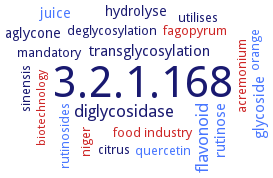3.2.1.168: hesperidin 6-O-alpha-L-rhamnosyl-beta-D-glucosidase
This is an abbreviated version!
For detailed information about hesperidin 6-O-alpha-L-rhamnosyl-beta-D-glucosidase, go to the full flat file.

Word Map on EC 3.2.1.168 
-
3.2.1.168
-
diglycosidase
-
flavonoid
-
transglycosylation
-
glycoside
-
rutinose
-
hydrolyse
-
juice
-
aglycone
-
acremonium
-
citrus
-
sinensis
-
mandatory
-
orange
-
food industry
-
quercetin
-
deglycosylation
-
fagopyrum
-
niger
-
rutinosides
-
utilises
-
biotechnology
- 3.2.1.168
-
diglycosidase
- flavonoid
-
transglycosylation
- glycoside
- rutinose
-
hydrolyse
- juice
-
aglycone
- acremonium
-
citrus
-
sinensis
-
mandatory
- orange
- food industry
- quercetin
-
deglycosylation
- fagopyrum
- niger
- rutinosides
-
utilises
- biotechnology
Reaction
Synonyms
6-O-alpha-rhamnosyl-beta-glucosidase, alpha-rhamnosyl-beta-glucosidase, alphaRbetaG, AMIS_8220, hesperidin deglycosylase, rutinase, rutinoside transferase
ECTree
Advanced search results
Engineering
Engineering on EC 3.2.1.168 - hesperidin 6-O-alpha-L-rhamnosyl-beta-D-glucosidase
Please wait a moment until all data is loaded. This message will disappear when all data is loaded.
additional information
immobilization of the enzyme by adsorption and crosslinking onto polyaniline-iron (PI) particles, method, overview. The immobilization yield and efficiency are relatively high, 31.2% and 8.9%, respectively. The heterogeneous preparation shows lower stability in comparison with the soluble form of the enzyme in operational conditions at 60°C due to protein metal-catalyzed oxidation achieved by iron traces supplied from the support. The harmful effect can be overcome by coating of the iron particles with polyethyleneimine (0.84 mg/g) previously to immobilization of the catalyst. The increased stability of the catalyst is correlated with the amount of iron released from the support. Under operational conditions, the uncoated particles lose between 76% and 52% activity after two cycles of reuse, whereas the PEI-coated preparation reduces 45-28% activity after five cycles of reuse in the range of pH 5.0-10, respectively


 results (
results ( results (
results ( top
top






